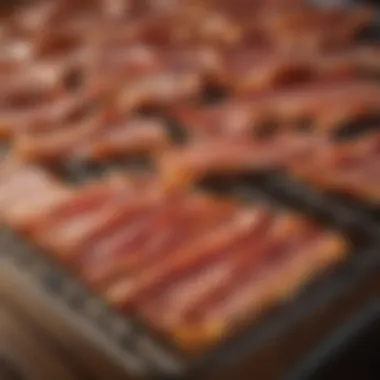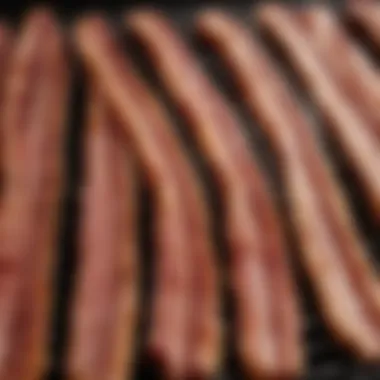Mastering Oven Bacon on a Rack: Perfectly Crispy Every Time


Intro
Cooking bacon in the oven has become a favored method for many home cooks and busy households. The benefits are undeniable. It offers a way to achieve crispy, evenly cooked bacon while minimizing the mess often associated with pan-frying. The magic truly lies in using a rack, which elevates the bacon above the grease that drips down during the cooking process. This technique not only enhances the flavor but also promotes healthier consumption with less fat retained in the bacon strips.
In this article, we will explore the intricacies of the oven bacon technique, highlighting various tips, suggested flavor variations, and lunch or breakfast pairing options. We will share methods to optimize the process, with a clear focus on diminishing the after-cook cleanup burden that so often deters people from tempestuous bacon escapades. For those ready to embrace this method, let's dive deeper into the essentials necessary for crafting mouth-watering oven-cooked bacon.
Recipe Highlight
Get ready to savor the experience of
Intro to Oven Bacon on Rack
Cooking bacon using the oven method has become a popular technique. It yields crispy and flavorful results. Many cooks prefer this over traditional frying methods. In this article, we will provide a detailed examination of oven cooking with a rack. Bacon that is cooked in this way not only reduces excess grease but also allows for even cooking.
Why Choose the Oven Method
Oven baking bacon serves many advantages over conventional frying. One of the primary benefits is ease of cleaning. A well-placed rack over a baking pan collects any excess grease. When feasible, using aluminum foil on the pan can further facilitate cleanup after cooking. Additionally, the oven enables more efficient use of space, allowing multiple slices of bacon to cook simultaneously.
Another notable benefit is the prevention of overcooked ends. Baking bacon gets rid of the flipping step, which is often required in a skillet. This allows each slice to maintain the intended crunch. Ultimately, oven baking produces consistent, highly satisfying results that appeal to both novice and experienced cooks.
Understanding the Equipment Needed
To begin your journey into oven-cooked bacon, you will need specific equipment. First and foremost, a rimmed baking sheet such as a half-sheet pan simplifies the process. This model effectively holds juices better than flatter ones. A solid rack, preferably oven-safe with small gaps, is essential to permit the grease to drain while allowing hot air circulation.
Reflecting on the choices, you may consider investing in a wire rack designed specifically for baking. These can sustain higher temperatures and produce superb crispiness. Using parchment paper could also help with easy extraction and minimize cleaning. Equipment of proper quality greatly enhances the cooking experience. Several brands, such as Chicago Metallic and Wilton, offer reliable products aimed at both home cooks and aspiring chefs.
In summary, selecting your tools is crucial for mastering this technique. Each element enhances the outcome, providing an enjoyable cooking experience from start to finish.
The Cooking Process
Understanding the cooking process is essential when masterin' the art of preparing oven bacon on a rack. This stage blends technique and timing, ensuring that the bacon reaches optimum crispiness while minimizing grease. Each detail contributes to the final result, affecting not ide generate taste but also texture.
Preparation Steps
Beginning with proper preparation has a significant impact on your bacon. Start by choosing high-quality bacon. Look for options that balance fat and meat; this ensures a rich flavor. Preheat your oven as a vital first step. A well-heated oven creates consistent cookin’ conditions, crucial for achieving desired results. Next, gather all tools needed: a rack, a pan, foil, and a knife if you choose to cut your bacon into smaller strips. Having these at hand cultivates a streamlined cooking process.
Setting the Oven Temperature
Determining the oven temperature is another key aspect in the bacon cookin’ process. For best results, set your oven to 400 degrees Fahrenheit. This temperature permits even cooking and creates that desired crispy exterior within a reasonable time frame. Avoid going lower, as this can result in bacon that is chewy rather than crisp. Remember to let the oven reach the target temperature before placing the bacon inside. Consistency in heat leads to daily favorable results.
Arranging Bacon on the Rack
How you arrange your bacon on the rack directly impacts the cook. Lay strips side by side with slight spaces between them. This allows hot air to circulate, facilitating even cooking while preventing overlapping. If overloaded onto the racks, areas may cook poorly. Adjust sizes or consider cook batches when needed. A approaching orderly setup pays dividends when taste-testing the final cooked bacon.
Timing the Cooking Process


Monitoring the time active for cooking bacon is crucial for perfectly mastered results. Generally, you should cook bacon for 15 to 20 minutes keeping an eye on its progress. At the halfway mark, it can be beneficial to flip the bacon strips to promote further even browning. Every oven is different; radiations do play factors on timing. If you enjoy different levels of crispiness, this could affect time until you dial in personal preferences.
Proper attention to timing can transform average bacon into an exceptional dish.
Mastering these elements within the cooking process will greatly enhance your experience with bacon as a dish, turning it into much more than just a breakfast side. By tackling each stage mindfully, you set yourself up to achieve remarkable outcomes.
Benefits of Cooking Bacon on a Rack
Cooking bacon on a rack in the oven is not merely a culinary trend; it holds distinct advantages that make it a compelling method for both seasoned cooks and casual food lovers. Understanding these benefits can elevate your bacon experience, ensuring flavors, textures, and cleanup are optimized. This section dives into three primary advantages of this technique: enhanced crispiness, reduced grease, and uniform cooking.
Enhanced Crispiness
One of the most sought-after qualities in bacon is crispiness. When bacon is cooked on a rack, it allows grease to drain away during the cooking process. This is essential, because avoiding a soggy bottom results in a delightful texture that many find appealing. Bakers often attempt multiple methods to achieve this experience, yet few match the efficiency of the rack method. Your bacon strands will be elevated above the grease, crisping up on all sides without steaming.
Furthermore, many find that consistency is often a challenge in stovetop cooking. Cooking the bacon in batches on a rack, you eliminate hotspots typical of most frying. One can observe how the consistent airflow surrounding the bacon, due to its position on a rack, leads to a satisfying crunch throughout each piece.
Reduced Grease
Reducing grease is another compelling reason to embrace the rack method. The excess fat that typically collects when frying results not only in unwanted splattering but also creates a heavy texture that some prefer to avoid. By allowing the bacon to hang in the oven, less grease accumulates on the food, making it a slightly healthier choice. Moreover, the dripping fat can be harvested for culinary uses, like gravies or frying other foods, presenting an opportunity to apply the bacon essence to different dishes.
By removing a significant amount of grease, your dish will not only taste better, but it can also enter your meal prep with fewer calories affected by the forming fat. This performance enhances the overall perception of the dish, improving sentiments on healthfulness without compromising rich flavors.
Uniform Cooking
Uniformity is crucial in many cooking practices, including bacon preparation. When randomly placed on a skillet, each slice might heat differently due to varied size or thickness. By laying bacon flat on a rack, when baked, the radiated heat surrounds the strips evenly. This ensures each piece cooks through to a satisfying doneness systematically, rather than fringes that may overcook.
Moreover, observing temperature differences helps gauge accuracy better. A static location minimizes the need to arrange pieces halfway through cooking, promoting efficiency in meal prep. This uniform cooking significantly reduces worry over undercooked pieces, which reflects in taste satisfaction.
Cooking bacon on a rack means every piece is treated fairly, reaching optimal crispiness, rich flavors, and tenderness regularly.
Tips for Perfect Bacon
Cooking bacon meticulously may appear simple, but it requires attention due to nuances. The consistency of the bacon, or how it's cooked can greatly affect the taste and texture of the dish. The provided tips will ensure that the bacon you prepare will be enjoyable every time, enhancing both flavor and texture for those indulging in your meal.
Choosing the Right Bacon
When it comes to the ideal bacon, quality is key. Look for bacon that has a balance of meat and fat; this ensures both flavor and desired crispness. Choices like thick-cut bacon offer more texture but require a bit longer cooking time compared to thin-cut varieties. Favor bacon that appears fresh and with minimal processing; taste rises significantly with higher quality, organic or artisanal options. Lightly applewood or hickory smoked types can also add pleasant nuances to your dish.
Spacing Techniques
Spacing the bacon on the rack correctly is crucial for leaving enough room for heat circulation. Avoid allowing pieces to overlap, as it causes uneven crispiness. Adequate space, typically about a quarter-inch to half-inch between strips, permits better airflow while maintaining a uniform shade of brown. Quirky alignment strategies like staggering strips can maximize space efficiency and consistency.
Flavoring Options
Variety is the spice of life and applies to bacon, too. Enhancing flavors can elevate ordinary bacon cooking to something memorable.


Spices and Herbs
Adding spices and herbs introduces complexity to bacon. Items like black pepper, paprika, or dried rosemary can amplify its flavor profundity. The balanced use of such additives often enriches the taste while still allowing the bacon's natural canvas to shine through. Sensibly, those with more pungent herbs should be stitched in options among milder seasonings to curate scented balance.
Marinades and Glazes
Utilizing marinades and glazes permits an infusion of flavors. Ingredients such as maple syrup, honey, or mustard can create flavors conducive to both sweet and savory undertones. The distinction with these is about the time; allowing the bacon to absorb these mixtures for several hours can result in an incredibly flavorful outcome. Caution should be taken, however, with too many sugars as this could potentially burn during baking.
Sweet and Savory Combinations
Combining sweet and savory aspects allows for a spectrum of tastes when cooked. Bacon blends nicely with fruits like figs or even apples, adding depth and an unexpected layer to palates. An artful balance in proportions ensures that no single flavor overtakes the other. Mistrust the intuition on flavor matchmaking as overall experience could sway uncomfortably if comparison lines draw too close.
Excellent bacon contains flavor layers which enhances the pleasing indulgence for any meal!p>
With these strategies on perfecting bacon preparation, better textures, balances, and tantalizing flavors become achievable. They not only promote indulgence but allow a creature comfort status from their universal appeal to amateur cooks and food lovers alike.
Serving Suggestions
Serving suggestions play a critical role in elevating the experience of oven-cooked bacon on a rack. How you choose to serve your bacon can enhance both its taste and visual appeal. Understanding different combinations with other dishes not only offers convenience but also provides varied flavor profiles to relish. Tailoring these serving ideas to different occasions also showcases the versatility of bacon.
With Breakfast Dishes
Oven-cooked bacon pairs effortlessly with a myriad of breakfast dishes, making it a vital component of a morning meal. One might consider dishes like scrambled eggs, avocado toast, or breakfast burritos. The saltiness and crispiness of the bacon contrast nicely with creamy or mild flavors found in eggs or vegetables.
Putting bacon alongside pancakes or French toast adds a savory punch that complements sweet syrups or fruit toppings. The weighty texture of bacon rather offsets fluffy lighter items, providing a balanced plate. When serving breakfast, consider the placement of food on the plate. A traditional setup could see bacon neatly arranged next to eggs, allowing for diversified bites without overwhelming the other flavors.
In Sandwiches and Wraps
Considering sandwiches and wraps, oven bacon becomes a strategic element. It fits not only as a main filling but also enhances the overall enjoyment factor among various ingredients. When paired with lettuce, tomatoes, and condiments like mayonnaise or mustard, it adds depth.
A classic BLT, where the textures and flavors of bacon, lettuce, and tomato harmonize effectively, is a widely cherished example. Alternatively, a breakfast wrap filled with eggs, cheese, and bacon offers convenience and taste cohesively bundled in soft tortilla. Bacon works great as both base layer and flavor enhancer, facilitating exchanges of tastes and consistency among ingredients.
Crispy bacon serves to maintain the structural integrity of the sandwich or wrap, making eating a tidier and more enjoyable experience.
In Salads and Appetizers
Including bacon in salads or as part of an appetizer broadens its applicability in culinary settings. Crumbled or sliced oven bacon captures attention when sprinkled over crisp greens or hearty mixed salad, providing texture. Salads that also contain creamy dressings such as ranch or Caesar benefit significantly from the smoky flavor of bacon, enriching each mouthful with complementary aromas.
For appetizers, consider serving warm bacon-wrapped dates. This delightful combination balances both sweet and salty profiles. Side snacks like bacon-wrapped asparagus or stuffed mushrooms indulge an array of tastes, making them popular choices at gatherings. When bacon is incorporated into smaller bites, its concentrated flavors elevate the snacking experience dramatically, ensuring appetite curiosity remains aflame.
Think of bacon not just as an afterthought but as an essential culinary twist that can improve a variety of meals.
Cleanup and Maintenance
Maintaining a clean cooking environment is crucial for successful oven bacon cooking. A careful approach to cleanup and maintenance ensures safety, enhances future cooking experiences, and extends the lifespan of your kitchen equipment. Without proper cleaning, residual grease and odors may linger, impacting both flavor and health.


Cleaning the Rack and Pan
After cooking bacon in the oven, it is essential to clean both the rack and the pan properly. Begin by letting the rack and pan cool slightly but not completely. If you find them still warm, it’s easier to remove residual grease. Use a spatula to scrape off any excess fat, which often clings to the surfaces. Following this, soak the rack and pan in hot soapy water for about 15 minutes. By then, much of the grease will lift away.
A stiff brush can work wonders to ensure all bits of bacon remain. Rinse thoroughly with clean water to remove soap and grease before allowing them to air dry. For stubborn grease spots, a mixture of baking soda and vinegar can aid in loosening tough remnants. Apply the paste, let it set, and scrub lightly. This method is enviroment-friendly and typically effective.
Tips for Reducing Grease Build-Up
Reducing grease build-up will not only make cleanup easier but also reduce any undesirable smoky smells during cooking. Here are two main practical tips you can utilize:
- Use Aluminum Foil or Parchment Paper: Line your baking pan with either aluminum foil or parchment paper before placement of the rack, making its surface non-stick. This technique allows you to dispose of excess grease easily.
- Adjust your Baking Sheet Location: Placement of your pan directly underneath the rack can capture drippings effectively. While bacon can impart lots of grease, limiting its spread is pivotal.
In essence, being proactive about cleaning after the cooking process will help maintain your cookware while enhancing the quality of your oven-cooked bacon experience.
Common Mistakes to Avoid
In the quest for perfect oven-cooked bacon, many home cooks fall prey to common mistakes that can significantly impact the outcome. Recognizing and understanding these pitfalls is crucial for achieving enhanced crispiness and a well-balanced flavor profile. Learning to avoid these errors ensures the cooking process runs smoothly, resulting in delicious, restaurant-quality bacon. In this section, we explore two primary missteps—overcrowding the rack and ignoring cooking time—to provide clarity and guidance to novice and experienced cooks alike.
Overcrowding the Rack
A common oversight occurs when too many strips of bacon are placed on the rack at once. This mistake not only reduces airflow but also prevents even cooking. When bacon strips are cramped, they often steam instead of crisping up, leading to a chewy texture rather than that desired crunch. \n To avoid overcrowding, choose a suitable rack and baking sheet combination. Each strip of bacon should be laid flat without touching others. If necessary, cook in batches. This might lengthen overall cooking time, but the result will be worth it. Here are key pointers to consider:
- Use the right size rack. A large rack allows for optimal heat circulation.
- Arrange strips side by side without overlapping. This maximizes exposure to heat.
- Batch cooking is effective. Sweeter tastes await if you prioritize quality over quantity.
Missing out on a crispy finish due to overcrowding diminishes the overall bacon experience.
Ignoring Cooking Time
Timing is equally important in the process of cooking bacon in the oven. Ignoring the recommended cooking time can lead to unappetizing results, either burnt bacon or undercooked strips lacking flavor. Consistently monitoring the progress can be altered by several factors like oven calibration and bacon thickness.
To achieve perfectly cooked bacon, instead of setting a timer and stepping away, consider:
- Checking bacon regularly after the halfway point. This allows you to determine the correct crispiness without overcooking.
- Trusting your judgment. Colors will change, and bacon will shrink as it cooks, indicating it's close to finish.
- Experimenting with different cooking durations. Each time may yield a different hint of flavor and texture, as preferences vary from crispy to chewy.
Ultimately, by remaining attentive to cooking time, you establish a mastering approach that caters to personal tastes and preferences overwriting any lazy habits that lead chefs astray.
Finale
Cooking bacon using the oven method on a rack is an efficient and effective way to achieve crispy, flavorful results with less grease. This method provides several advantages, including even cooking, reduced mess, and consistent texture. Throughout this article, we discussed the step-by-step process to master this technique, emphasizing the significance of preparation and timing. Proper arrangement on the rack allows fat to drain away, leading to a better final product.
Recap of Key Points
- Why Choose the Oven Method: Baking bacon in the oven yields better results than pan-frying by ensuring even heat distribution.
- Preparation Steps: Starting with a cold oven can help in achieving more evenly cooked bacon, offering distinct texture variations.
- Arranging the Bacon: Spacing the bacon strips on the rack is crucial to avoiding overlap and ensuring even cooking.
- Timing: Adjusting timers based on desired crispiness reduces the chance of burning.
- Flavoring Options: Enhancing bacon with varied spices and marinades can take flavors to another level, allowing for versatility in your dishes.
- Cleanup Tips: Efforts during cleaning can lead to easier maintenance of cooking tools and less mess overall.
Encouragement for Experimentation
After mastering the basic technique, there’s room to innovate. Don't hesitate to explore different types of bacon, from thick-cut to flavored varieties. Adjust temperatures for varying results; some may favor crispy bacon while others enjoy a chewier texture. Mixing flavors, such as maple syrup or smoked pepper, elevates the dish further.
Feel free to experiment with cooking times. Not every oven behaves the same, meaning personal experience will perfect timing. Use observations from these tests to refine your approach. Try pairing bacon with unusual complements in meals or use it in innovative recipes that go beyond traditional breakfast fare. Discovering new ideas may bring a delightful surprise to your dining table.
*“Experimentation leads to innovation. Every test can offer insight stronger than any printed recipe.







